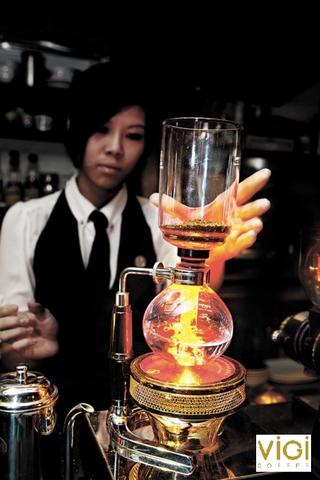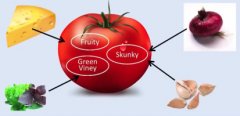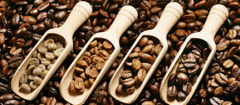Hong Kong Siphon Coffee Champion Brewing Tips Share

For professional baristas, please follow the coffee workshop (Wechat official account cafe_style)
Many coffee enthusiasts have a siphon pot at home. Although the brewing process is not difficult, it may not be possible for all of them to win a prize or even become a master. At the Accro Coffee Hong Kong siphon barista contest, I met Pinky, who ranked No. 1 in the world in 2013 and won the siphon barista contest in Hong Kong for two years in a row. I stopped by to ask her for some tips on how to brew champion siphon coffee.
Champion coffee beans
In order to become a siphon master, it is not as complicated as imagined. First of all, let's talk about coffee beans: in the siphon barista contest in Hong Kong, most of the contestants chose the reserved Panamanian geisha (Geisha), while Pinky chose the suntanned pearls of Yegashev, Nyer iAA of Kenya and Ras Larrajas of Costa Rica, which were matched with three medium-priced boutique beans. A good match does not necessarily use the most expensive coffee beans. If you want to become a champion bean, you must go through five hurdles and go through countless tests of baking degree and taste before you can successfully find the perfect combination. The match of this champion is by no means a false name. Yegashev is the most famous coffee producing area in Ethiopia. Washed Yegashev has clean and delicate aromas of flowers, orange and lemon; Gostrica tanned pearls have rich and bright red cherry fruit flavors with outstanding sweetness and warm feeling; Kenyan Nyeri AA has a touch of Zhu Guli and the sweetness of ripe nuts, enhancing the layer and thickness of the blend. The combination of three beans makes this cup of champion coffee aroma, sweet, sour, chocolate and nut flavor, very balanced, refreshing and refreshing, even emitting different flavors at different temperatures, with rich layers, suitable for drinking before meals. Wake up your stomach.
Tips for champions
If you have good coffee beans, you should also make careful preparations. Even if it is as simple as a bean grinder, you cannot be careless. The roughness of each bean grinder is different, and the scales of different brands will vary greatly. Pinky uses a Japanese Kalita electric bean grinder with a scale of 3-4, which produces less coffee powder than coffee sugar.
Some baristas put the hot water on the pot before adding the coffee powder, while the Pinky put the coffee powder on the water. If the powder falls into the water, the coffee powder will have a certain impact force when it hits the water, so that the powder layer will come into contact with hot water for different times, so that the extraction time and taste will be affected, and the impact force and the speed of falling powder will be difficult to control, and the quality will be difficult to unify.
A pot of well-brewed coffee should clearly see the upper, middle and lower three layers: the top layer is white foam, the middle is the coffee powder layer, and the bottom is coffee (water). If there is no or little foam on the top layer, it means that the position of the filter is crooked.
Selective strainer
Siphon pot has filter cloth, filter paper and metal three kinds of filter screen, Pinky will choose the traditional filter cloth as filter screen. The used filter cloth must be soaked in water for a long time and changed every day, and then washed with hot water before cooking. The best way to clean the filter cloth is to cook it in a siphon pot, that is, just like you usually make coffee, but without coffee powder. When the hot water still stays in the top pot, pour out the water and do not let the water filter back into the bottom pot. The purpose of this is to loosen the fiber of the filter cloth and to prevent the hot water from cooling sharply when it touches the filter cloth. If you don't cook very often, you can change a new piece of cloth every two weeks or a month. The filter screen should be placed in the middle. If it is in the right position, there will be some evenly distributed and small bubbles rising; if it is placed askew, the atmospheric bubble column will tumble in the water, and the bubble column will constantly penetrate and hit the powder layer, making the extraction uneven.
Mixing rods and techniques
There are many mixing rods of different materials and shapes, says Pinky. The most important thing is to match. Some Japanese use paddle sticks to shake back and forth, while she chooses bamboo sticks. Rinse the bamboo stick with hot water before and after each use to wash the coffee grease and taste off the surface and preheat the bamboo stick.
At first, when the coffee powder is wet with hot water, stir once with a bamboo stick and stir in a circle at a speed of about one circle per second to help the coffee powder wet the water evenly. Then boil for about 50 seconds, no more than one minute at most, and stir again when the coffee is extracted, in order to help release the flavor of the coffee. That is, stir twice before and after.
Contestants are required to brew five pots of coffee at the same time within 15 minutes. Each pot of coffee grounds must be of the same shape. Wash it as soon as possible after each brewing, because if the coffee oil hangs for too long, the color is more difficult to wash. Simply clean the siphon pot with clean water and dishcloth. Never use detergent or brush.
Tips for siphon coffee brewing
Successful chefs usually don't mind sharing recipes because they can keep innovating! Pinky is also happy to share her winning experience in making siphon coffee.
Tools:
HARIO TCA-3 siphon glass coffee maker
Long-body stirring stick (bamboo, wood or plastic)
Bean grinder
Halogen lamp heater (or other heat source)
Electronic scale
timer
Materials:
20-21 grams of coffee beans
200-210 ml hot water (brewing coffee)
50-100 ml hot water (pre-soaked filter cloth)
Extraction amount: 1 part of coffee beans is better than 10 parts of water.
World siphon baristas Competition (The World Siphonist Championship)
Web site: worldsiphonistchampionship.org
Writing, photography: talk about Virginia Tam (founder of Vigi Coffee, approved trainer of American Fine Coffee Association, recognized instructor of Diploma in Coffee Studies of European boutique Coffee Association, Japanese final judge of 2014-2016 World siphon barista Competition, workshop instructor of Hong Kong siphon barista contest, president of Hong Kong Coffee Culture Promotion Association, organizer of 2011 Food Expo Coffee Street. Www.facebook.com/vigicoffee)
Important Notice :
前街咖啡 FrontStreet Coffee has moved to new addredd:
FrontStreet Coffee Address: 315,Donghua East Road,GuangZhou
Tel:020 38364473
- Prev

Scientific analysis teaches you to find coffee and diet.
Please follow the coffee workshop (official Wechat account cafe_style) when you cook spaghetti, have you ever wondered why tomatoes are cooked with onions and cheese? Can tomatoes go with coffee? Recently, I have seen some netizens use coconut green to make iced coffee, so is it okay to use garlic to make coffee? Food matching (food pairing) is a new research. Tradition
- Next

Is the taste of single coffee beans too monotonous? Make good use of the know-how to match your own flavor
Communication of professional baristas Please pay attention to the coffee shop (Wechat official account cafe_style) different kinds of coffee beans from different places, each with its own unique taste, aroma and taste, you can make your own coffee by mixing according to your favorite flavor. Author = Choi Rongxia (Korean, now a well-known barista college coffee MBA college and coffee start-up and circulation company Dream
Related
- What is the meaning of lactic acid fermentation with coffee bean treatment?
- How to judge the state of foam by sound?
- How does the latte pull out the unicorn pattern? Come to get for a little trick to improve the flower pull!
- Will flower pulling affect the taste of the latte?
- Do you know the history of coffee?
- The difference between honey treatment and sun washing what is raisin honey treatment?
- What kind of milk can a novice use to make coffee foam to keep the foam longer? The correct method and skills of milking tutorial sharing
- Why do washed coffee beans taste sour? Flavor characteristics of washed Coffee
- Introduction to the skill of how to practice the size and height of water injection around the circle of hand-brewed coffee
- How do beginners practice coffee flower drawing from scratch?

